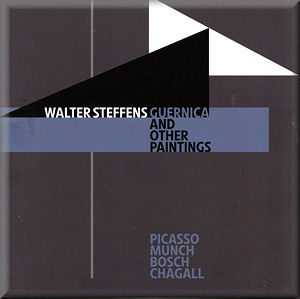 |
 |
| 

Sound
Samples & Downloads
|
Walter STEFFENS (b.1934)
Guernica and Other Paintings
Guernica after Pablo Picasso, elegy for viola and orchestra,
Op. 32 [14:14]
Siguiriya after Edvard Munch 'Skrik' (The Cry), for mixed
choir, Op. 3c [3:59]
Pintura del Mundo (The Garden of Earthly Delights) after Hieronymus
Bosch, for orchestra [18:39]
Le Cantique des Cantiques (The Song of Songs) after Marc Chagall,
symphony for organ, Op. 84 [40:45]
 Rainer Schmidt (viola); Northwest German Philharmonic, Herford/János
Kulka (Guernica); North German Radio Choir/Helmut Franz (Siguiriya);
North German Radio Symphony Orchestra/Klaud Weise (Pintura); Frierich
Flamme (organ) (Cantique).
Rainer Schmidt (viola); Northwest German Philharmonic, Herford/János
Kulka (Guernica); North German Radio Choir/Helmut Franz (Siguiriya);
North German Radio Symphony Orchestra/Klaud Weise (Pintura); Frierich
Flamme (organ) (Cantique).
rec. 21 Aug 2005, Muhleisen Organ, St Paulus Church, Harsewinkel,
Germany (Cantique); otherwise on information supplied.
 LABOR RECORDS LAB 7084 [77:37]
LABOR RECORDS LAB 7084 [77:37] 
|
|
|
Various composers, most notably Scriabin have tried to translate
music into colour and vice versa. The challenge of the
next step when music portrays an image has been irresistible
to a much larger range of composers. Music inspired by landscapes
is one thing (I think of Hadley’s The Hills and Bax’s
Tintagel) but what about music inspired by paintings?
There are plentiful examples including Rachmaninov’s Toteninsel
(Böcklin), Mussorgsky’s Pictures (Hartmann), Granados’s
Goyescas and Louis Aubert’s Tombeau de Chateaubriand.
Walter Steffens was a composition student of the Busoni pupil Philip Jarnach in Hamburg. His Opera Under Milk Wood based on the ‘play for voices’ by Dylan Thomas was written for the BBC. He has for the last five decades been gripped by expressing paintings in music. There are more than a hundred such works based on paintings by Bosch, Rubens, Chagall, Picasso, Klee, Munch, Aubertin, Soto, Penck and Schumacher.
His music is au fait with dissonance but this is not ultra-ivory tower material. His Guernica is an elegy which also picks up on his memories of the Allied bombing raids on his home cities of Aachen and Dortmund. It is hoarse, humming with abrasion and overarched at the start, by a siren. The viola is by no means a passive presence. It plots a raw course through the destruction and finally finds peace. The date of the recording is not given but given the hiss (for this track only) it must be analogue. The brief but intense Siguiriya is for mixed choir and draws on Munch and Lorca, images and poetry. The singing is densely volatile and flammably operatic. It can be heard as a violent counterpart to Penderecki’s Hiroshima Threnody. Pintura del Mundo starts with the peaceful but far from bland disposition of the closing pages of Guernica. This orchestral piece is tense; it groans and brays with horror. The Dialogue first movement tends towards stasis. The chittering and birdsong of Bosch’s nightmare insects and feathered horrors can also be heard. The music gathers wild pace in the second and last segment: Magog. The solo organ work, Le Cantique des Cantiques is the most extended piece here at some forty minutes. Marc Chagall’s ‘Song of Songs’ is the inspiration. It is complex and emotional, dignified, awed and occasionally shuddering with horror or wild-eyed with growing hysteria (part V, tr. 11, 6:33); not that there isn’t a great deal of gentle and calming music. The idiom is not particularly difficult if you are comfortable with Messiaen. Friedhelm Flamme is the organist. He has already made many CDs for CPO in his survey of North German baroque organ music. For the same label he also recorded organ works by Duruflé and Langgaard.
The movements of Le Cantique des Cantiques are:-
Prolog: Sch'ma Israel (Höre, Israel) 6:17 (Hear, O Israel / 5. Moses 6,4-9)
I. Nordwind erwache! Südwind herbei! 4:08 (Awake, O north wind; and come, thou south / The Song of Songs 4.16)
II. Ich schlafe, aber mein Herz wacht 9:48 (I sleep, but my heart waketh / The Song of Songs 5.2)
III. Am Tage seiner Hochzeit 3:46 (In the day of his espousals / The Song of Songs 3.11)
IV. Zieh mich mit dir, jauchzen wir und jubeln 5:59 (Draw me, we will run after thee: we will be glad and rejoice in thee / The Song of Songs 1.4)
V. Stark wie der Tod ist die Liebe 10:17 (Love is strong as death / The Song of Songs 8.6).
The sung words are not printed in the leaflet. This is a good foldout effort with an essay by Christopher Zimmermann.
Steffens takes with utmost seriousness the transcribing of music from paintings. The results are fascinating and can hold the attention without fore-knowledge that what you hear began as something seen by the composer.
Rob Barnett
|
|

